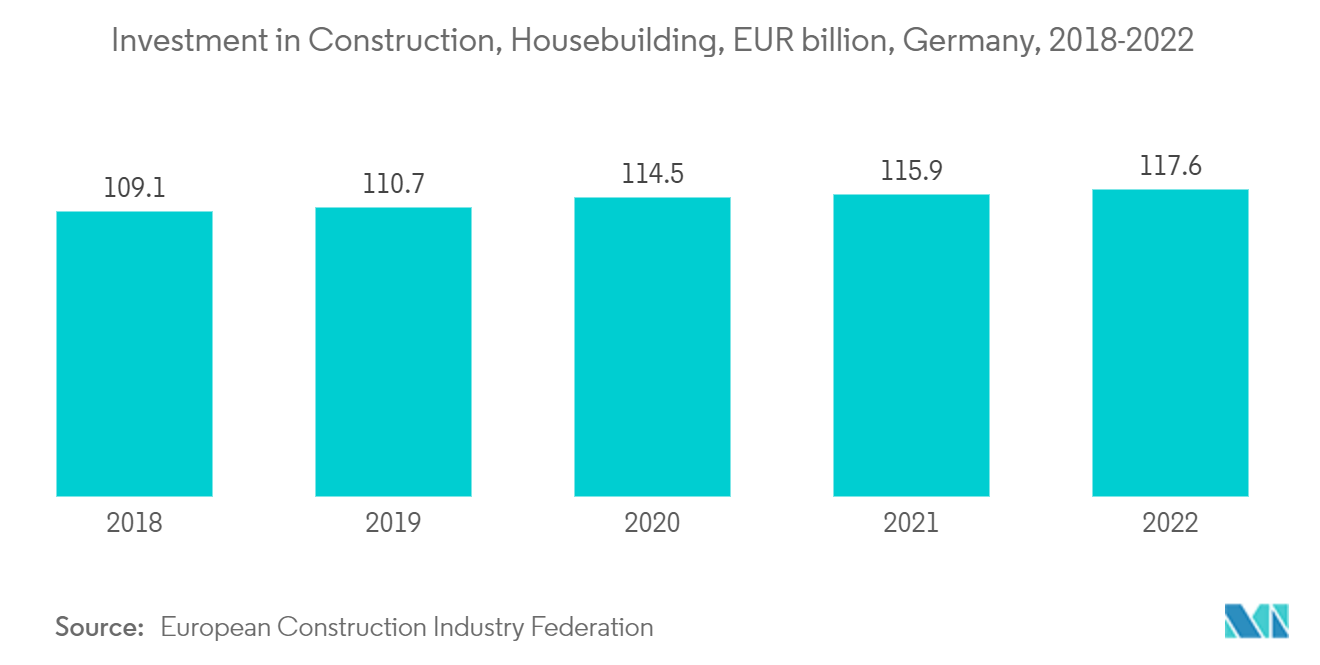Market Trends of Europe Decorative Laminates Industry
Furniture Industry to Dominate the Market
- The European Union is a world leader in the high-end segment of the furniture market. Nearly two out of every three high-end furniture products sold in the world are produced in the European Union.
- The United Kingdom, Germany, Italy, Spain, and Poland are among the major furniture markets in the region.
- Manufacturing of beds, furniture, and other items in the United Kingdom is a sector that is expanding significantly. According to the Office for National Statistics (UK), consumer spending on furniture and furnishings was over GBP 25.13 billion (USD 31.98 billion) in 2022, up from GBP 23.12 billion (USD 29.42 billion) in 2021.
- According to UN Comtrade, in 2022, the United Kingdom exported approximately USD 61.82 million worth of wooden office furniture compared to USD 53.91 million in 2021, representing an increase of 14.6% over the 2021 figures. Furniture, bedding, and mattress exports were around GBP 2.84 billion (USD 3.61 billion) in 2022.
- The furniture industry plays an important part in the Italian economy. Italy is the world's fourth-largest furniture manufacturer at the global level. According to FederlegnoArredo, the association of companies in the Italian furniture sector, Italian furniture production increased by 12.7% in 2022 compared to EUR 49 billion in 2021.
- The increase in growth of the wood furniture industry was made possible by the inventiveness of the supply chain, with a current manufacturing value of over EUR 57 billion (USD 62.66 billion). With a manufacturing turnover of over EUR 29 billion (USD 31.88 billion), the furnishing macrosystem has grown by 11.1%, the wood macrosystem (production turnover of more than EUR 23 billion (USD 25.28 billion)) by 14.3%, and the timber trade has grown by 15%, reaching over EUR 4 billion (USD 4.40 billion).
- According to the Spanish National Association of Furniture Manufacturers and Exporters in Spain (ANIEME), the value of Spanish imports of living room furniture increased by 13.2% to EUR 4.04 billion (USD 4.44 billion) in 2022 compared to EUR 3.57 billion (USD 3.92 billion) in 2021.
- Spanish furniture's primary export markets are in the European Union. France, Portugal, Germany, and the United Kingdom make up the majority of exports (60%), ranking among the top six markets for Spanish furniture. With the exception of Italy, every one of them exhibits a double-digit increase in purchases, demonstrating the significance of Spanish furniture in their respective markets.
- As for the furniture industry in Poland, according to Eurostat, exports increased by 8% to reach EUR 14.44 billion (USD 15.87 billion) in 2022. Germany, the Czech Republic, and France were the major export markets. Furniture imports increased by 7% to EUR 3.77 billion (USD 4.14 billion) in 2022.
- With most European countries leading in furniture production and exports, the decorative laminates market is set to witness positive growth during the forecast period.

Germany to Dominate the Regional Market
- The woodworking and furniture market is an important sector of the German economy, constituting around 7% of the total consumer goods market in Germany. The sector recorded an increase of more than 12% in revenue in 2021 over 2020. The high consumer purchasing power creates opportunities for manufacturers to innovate.
- Some of the key players in the German furniture industry are Huls AG & Co. KG, Topstar GmbH, and Rauch GmbH & Co. KG. Most of the companies are in Bavaria, Baden-Wurttemberg, and North Rhine-Westphalia. Currently, there are over 22,000 furniture manufacturers across the country.
- In 2022, the German furniture business saw a 7% increase in sales compared to 2021, reaching EUR 18.8 billion. According to the Association of the German Furniture Industry (VDM), there was a 10% increase domestically and a 12% increase internationally in 2022 for German furniture producers compared to 2021. The estimated growth in export sales was around 9.8%, while the furniture industry in Germany grew by 5.4%.
- The federal states of North Rhine-Westphalia, Bavaria, and Baden-Württemberg account for almost three-quarters of the German furniture industry's total revenue. Lower Saxony, Hesse, and Saxony are other significant producing regions. A third or so of the output gets exported. The biggest overseas market is France, which is followed by Switzerland, Austria, and the Netherlands. The United States, China, and Russia are the three biggest non-European markets.
- According to the European Construction Industry Federation, the new construction order value in Germany in 2022 was EUR 99 billion, 4.8% more than that of 2021.
- The number of building permits in residential construction was 354,403 in 2022. A total of 68,700 residential building licenses were issued from January to March 2023, a decrease of 25.7% from the same period in the previous year (January to March 2022: 92,500 building permits). The drop in construction projects was most likely caused by the high cost of building materials and the aftereffects of the Russia-Ukraine Crisis.
- However, the construction of hotels in Germany is expected to witness a sharp rise in the forecast period. As of 2021, a total of 360 new hotels with 56,565 rooms had been in the pipeline. The year 2022 saw the launch of 89 new hotels and 15,780 rooms. Around 78 more projects with 13,073 keys have been mooted for 2023. The pipeline of hotels is anticipated to stay strong for 2024 and beyond, with 153 projects and 22,769 rooms already in the works.
- Although the construction industry is not growing at a rapid pace in Germany, the furniture market will likely compensate for the demand for decorative laminates in the country.


